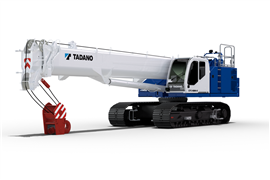The Liebherr edge
18 April 2008
German crane maker Liebherr, which has long been a force in the world crane market, has enjoyed a loyal following in the United States for many years. But it has just been in the last 10 years that Liebherr has become a major player in the crane market in North America, first making its mark in the all-terrain arena, and now competing in the crawler and duty cycle crane markets as well.
Much of Liebherr's success in the US over the last three years has been under the watch of Hans-Georg Frey, managing director of the mobile and heavy crawler crane operation at Liebherr-Werk Ehingen in Germany. During Frey's tenure, Liebherr has prospered worldwide, and especially in the US. Testament to the brand's success in the US happened last fall, when long-time Manitowoc customer Essex Crane Rental made the decision to add several Liebherr models to its fleet. Other strong Liebherr customers in the US include Buckner HeavyLift, Digging and Rigging, Cranes Inc. and Bay Crane. Last year, to show its commitment to the US market, Liebherr opened an impressive product support and service center in Houston.
Last spring, when Frey was in Houston after an eight-city tour of the US calling on customers, and in early May in Germany, D. Ann Shiffler and Alex Dahm, editors of American Cranes & Transport and International Cranes and Specialized Transport magazines, respectively, interviewed Frey and discussed issues related to crane sales, demand, market implications and the like. Following are excerpts from those interviews.
You took over at Liebherr about three years ago, when the state of the crane market was at a low point, but then a year later the market started to rebound. How is Liebherr performing in the current upturn?
The situation is very interesting actually. For the first time, the whole world is going strong. We have hardly any markets that are slow. We are quite a force in Europe with Spain and Germany being the number one markets. Our market in the UK is also very strong. In looking overseas China and the Middle East are important markets. And the USA, after quite a recession and Brazil are enjoying very strong sales.
Last year Liebherr sold several cranes to Essex Crane Rental, a company that has traditionally bought mainly Manitowoc cranes. Will Essex be buying more Liebherr cranes?
We are happy to see that Essex chose to add cranes made by our colleagues from Liebherr Nenzing. We know that they are quite happy with the equipment. We will continue to talk with them about our cranes and think they will continue to order Liebherr cranes. They are evaluating that now. Essex has been very Manitowoc. But it is very important for a company to see that you aren't just looking at one single source. With their base, they now are looking at other good brands.
In the last two years, the all terrain crane has begun to enjoy wide-scale acceptance in the North American market. How is Liebherr performing in this market in the US and Canada compared to its competitors?
First of all I think the market for all terrain cranes in the US had been very strong some years ago. Then the market drastically went down but that had nothing to do with all terrains, it was across all crane types. In the last two years this market has again started to come up and, yes, we are seeing that the all terrain concept is more and more accepted in the US as well.
Worldwide, there is a nice acceptance for the AT, particularly in Europe. Many companies have totally changed over to the AT concept. But we are convinced that there will not be 100% acceptance of the AT concept. There are certain applications where the RT has demand and an advantage, and in the US, the truck crane too. I think the AT concept will be more and more accepted and will replace either the RT and truck crane but as I said, not 100%.
We are very happy about Liebherr's performance with the AT. Our market improved significantly in 2004 and 2005 and we went into 2006 with a very nice order book.
How do you describe the distribution model for Liebherr cranes in the US? Why does Liebherr not use dealers in the US? Do you ever envision a “traditional distribution” model?
I think we are number two in the US market, with Grove at number one. And we are increasing our market share. We are not so old in the US market - we took over our dealer, Schiller, two years ago and made our own direct sales approach that we have in every market. We simply believe in having the direct contact with our end customer and not just having contact with dealers.
Also, we think it allows us to invest more strongly in our after sales facilities. Dealers often have limited financial facilities, and we feel it is necessary sometimes to build a repair shop or service station and we have the resources to do so. The best example is our facility in Houston. Right now it is very big but in a few years' time it will be absolutely adequate. We have sales and service people there.
The distribution set up of our competitors is different from ours in that they work with distributors, whereas we work almost exclusively with our own people.
How does it work with the separate official distributors of Liebherr's different divisions? At the Houston facility, we are seeing some of the different crane types being brought together? Are there any plans to extend this principle?
Only if it makes sense do the various Liebherr divisions cooperate. The businesses are so different so if it doesn't bring synergies it makes no sense. Whereas if it pushes the brand and the name it is quite alright. That is why we are, for example, in our headquarters in Newport News, VA together with all our other colleagues from earthmoving and from mining, all in the same building. But we maintain our separate distribution channels.
Is there a similar setup to the US anywhere else in the world?
Again here we have what depends on the market. In the US, our colleagues from the tower crane [group] have a dealer, Morrow Equipment, so obviously that is a totally different setup. And so they are not under the same roof as we are. And I think we are doing quite a good job. You cannot bring everything so easily together because simply the markets, the sales channels, are different. Obviously, if you have one building somewhere in a country like Russia everybody moves in there, that's different. In Moscow all of us are in the same building. It makes sense because it pushes the brand.
It is very much the Liebherr organization - in all big markets you will find a Liebherr company and we operate only with our own people. There is only one area left where we -Liebherr Ehingen - have a dealer - the eastern part of Australia, where we have a distributor. All other markets are either Liebherr people or agents who are being supported by Liebherr people. We take a direct marketing approach not the distributorship approach.
The Houston facility has been operational for almost a year now. Have the goals been met for this facility?
First of all, it was important we set up a facility for our customers. We are offering services which other competitors are not offering in a similar way. The erection of this facility was well received by our customers. It was a way for them to see that we are not just coming into the market [when the market is strong] and then going out. It was a serious permanent investment. Our competitors have noticed it too. If we need to build another facility in the US, we have a philosophy that when or where there is a need, we will respond. We have service and repair facilities like the one in Houston all over the world.
Does Liebherr have any plans for crane manufacture or the assembly of crane kits in the US?
Not in the immediate or foreseeable future. In Liebherr, we have achieved a fine situation and we have a very highly technological product. We have our vendors in place and our cranes are built at the most modern manufacturing facilities in the world. It is very difficult to improve by shifting a part of your manufacturing to another country. Selling kits would increase costs. Also important, you need to look at the skills needed to make such a highly technical product. It is hard to find and develop this type of operation that makes sense from a cost aspect.
How is Liebherr dealing with supply issues and long delivery times?
Delivery times can be as short as the end of this year but also as long as the end of next year, depending on the type of machine. And you find anything in between but the minimum is the end of this year.
We were seeing tremendous increases in prices for components and steel. We were seeing and still are seeing shortages in components, especially tires. In fact, tires are the limiting factor for increasing production today.
Customers are still ordering. They have realized that they need to order now to get a crane even in a year or so. People are aware of this situation and they are adjusting to it. When the world is booming like it is today everybody wants cranes and then, of course, your order book becomes larger and larger and we are limited in increasing our production as already mentioned.
Are used cranes being supplied, perhaps as stop-gap cranes, until a new one can be delivered?
The used crane market goes hand in hand with the new crane market. With the strong demand for new machines and the non-availability of new cranes, the demand for used cranes gets stronger. The used crane market is practically empty, worldwide.
Used machines are being sold to the US market. We have always been strong in the used crane business. That is why we have the crane center in Houston, for selling, repair and servicing of machines for the US market.
What did you think about the purchase by Bigge Crane & Rigging of the Liebherr LR 1800 at the auction on the West Coast earlier this year?
I am not allowing our people to pay these prices just to get machines to sell on, because in two or three years we will be confronted when the market goes down, so we are trying to moderate it. I think the price paid was high but, looking at the availability of the machine, it may have been cheap, depending on the rental rate they get. It is all a matter of calculation. Compared with two years ago the price paid was high but you are not paying the value of the machine, you are paying for the availability of the machine.
STAY CONNECTED


Receive the information you need when you need it through our world-leading magazines, newsletters and daily briefings.
CONNECT WITH THE TEAM











